“Only those who dare to fail greatly can ever achieve greatly.”
Robert F. Kennedy

“Only those who dare to fail greatly can ever achieve greatly.”
Robert F. Kennedy
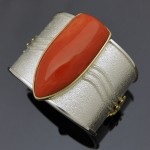
A large cabochon of Pacific salmon colored coral set in sterling silver bracelet with 18k yellow gold accents. Photo courtesy of the artist, Darryl Dean Begay.
Coral has been treasured for centuries. Precious coral comes in pastel colors of white, pink (often called angel skin), and salmon orange, but it is the deep red variety that is the most valued. Historically, the finest red coral has come from the Mediterranean. However, much Mediterranean coral is protected today. Stones from this region are being cut from branches harvested many years ago, says John Heusler, of Slabs to Cabs in California.
The waters off the coasts of Japan and Taiwan produce most of the high-quality red coral now coming onto the market. So-called “ox blood”—dark red–coral is in great demand, particularly among Japanese and Chinese buyers. Chinese collectors in particular are “insatiably consuming … beaded [coral] jewelry strands,” according to coral supplier Massa Gioconda SAS, in Naples, Italy.
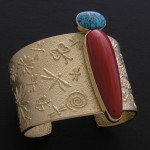
This 18k yellow gold bracelet is set with Mediterranean coral from old stock. Mediterranean coral is rare, due to environmental protection. Photo courtesy of the artist, Darryl Dean Begay.
In fact, coral beads have always been—and continue to be—the most popular form of coral jewelry. Drum or barrel shape beads are often chosen in Tibet, says Jeffery Wang of Pao Hung Coral in Taiwan. In the US, where coral is often combined with turquoise and associated with southwestern Native American cultures, bead buyers often choose tubular beads or those made from thin branches. (Coral is used in Native American inlay as well.) However, “round beads have always been considered a ‘classic’ which every woman should have,” according to Massa Gioconda.
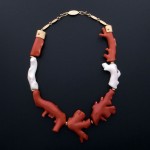
Neckpiece of white and red branch coral with 18k yellow gold accents. Darryl Dean Begay’s work finds enthusiastic collectors in Asia, particularly Japan. Photo courtesy of the artist, Darryl Dean Begay.
Coral may be cut into cabs or carved into a variety of shapes. Freeform sections of branches “[inspire] jewelry designers all over the world for their one-of-a-kind pieces,” says Massa Gioconda. However, due to the increasing rarity, Heusler says he prefers to cut natural shapes. “We treat it like the finest opal. It’s a shame to cut to calibrated sizes [because of the waste].”
Coral grows very slowly. Older, larger coral is rarer, so larger cabs, carvings or beads are “exponentially” more expensive than smaller pieces. Price also depends on the quality of the coral—the desirability of the color, consistency of the color, its freedom from holes, pitting or other blemishes. In a strand of beads, the quality of the matching also plays a part. Wang says that coral prices, which are based on weight, range from US$5 per gram to US$2000 per gram.
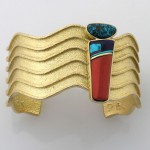
18k yellow gold bracelet with turquoise and lapis. Native American jewelry artist Darryl Dean Begay draws on his culture’s tradition of setting coral with turquoise, but with a contemporary twist. Photo courtesy of the artist, Darryl Dean Begay.
Because it has been extracted for centuries, precious coral in many areas has disappeared. In others, the remaining coral beds are protected.
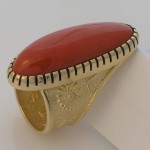
A perfect piece of red coral is all that is needed in this 18k yellow gold ring. Photo courtesy of the artist, Darryl Dean Begay.
In addition, precious coral is found at ocean depths of 300 to more than 1000 meters where the water is clear, dark and still. To remain healthy, all coral demands fairly constant water temperature between 13oC to 16oC. When temperatures go higher or lower, coral begins to die. For that reason, coral suppliers express concern about global warming and rising water temperatures which may increase the gemstone’s rarity.
First published in Jewellery Net Asia.
“Anyone who has never made a mistake has never tried anything new.”
Albert Einstein
“Just dash something down if you see a blank canvas staring at you with a certain imbecility. You do not know how paralyzing it is, that staring of a blank canvas which says to the painter, you don’t know anything.”
Vincent van Gogh
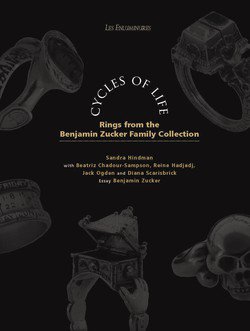 Cycles of Life: Rings from the Benjamin Zucker Family Collection; Sandra Hindman, with Beatriz Chadour-Sampson, Reine Hadjadj, Jack Ogden and Diana Scarisbrick; With an essay by Benjamin Zucker; Paul Holberton Publishing, London; 258 pages, color illustrations; ISBN 9780991517237; $50.00
Cycles of Life: Rings from the Benjamin Zucker Family Collection; Sandra Hindman, with Beatriz Chadour-Sampson, Reine Hadjadj, Jack Ogden and Diana Scarisbrick; With an essay by Benjamin Zucker; Paul Holberton Publishing, London; 258 pages, color illustrations; ISBN 9780991517237; $50.00
Cycles of Life: Rings from the Benjamin Zucker Family Collection by jewelry historian Sandra Hindman, celebrates 40 years of collecting by gem dealer Benjamin Zucker. The book is the third in a series of jewelry art history by Hindman published for Les Enluminures, a gallery specializing in manuscripts, miniatures, and jewelry from the Middle Ages and the Renaissance.
Hindman has organized a selection of rings from the Zucker collection, much of which had been on loan to the Walters Art Museum since 1985, according to the talismanic, symbolic and commemorative roles rings have played at birth, marriage, death, in everyday life, and even as a symbol of eternity. These are the sections into which the book is divided. Continue reading
“So long as one can live and pursue his natural vocation in art, it is a duty with him never to abandon it if he believes that he has within him the elements of final success. Every time he labors at aught that is not art, he robs the divinity of what belongs to her.” Lafcadio Hearn
“So long as one can live and pursue his natural vocation in art, it is a duty with him never to abandon it if he believes that he has within him the elements of final success. Every time he labors at aught that is not art, he robs the divinity of what belongs to her.”
Lafcadio Hearn
“Look for your own. Do not do what someone else could do as well as you. Do not say, do not write what someone else could say, could write as well as you. Care for nothing in yourself but what you feel exists nowhere else—and out of yourself create, impatiently or patiently…the most irreplaceable of beings.”
André Gide
“Look for your own. Do not do what someone else could do as well as you. Do not say, do not write what someone else could say, could write as well as you. Care for nothing in yourself but what you feel exists nowhere else—and out of yourself create, impatiently or patiently…the most irreplaceable of beings.”
André Gide
“I dwell in possibility.”
Emily Dickinson